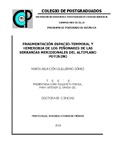| dc.contributor.author | Guillermo Gómez, María Asunción | |
| dc.creator | GUILLERMO GÓMEZ, MARÍA ASUNCIÓN; 337674 | |
| dc.date.accessioned | 2019-05-21T19:01:35Z | |
| dc.date.available | 2019-05-21T19:01:35Z | |
| dc.date.issued | 2019-05 | |
| dc.identifier.uri | http://hdl.handle.net/10521/3176 | |
| dc.description | Tesis (Doctorado en Ciencias, especialista en Botánica).- Colegio de Postgraduados, 2019. | es_MX |
| dc.description.abstract | El presente estudio documenta el uso del Índice de Hemerobia, para estimar el efecto de la intervención humana en las zonas boscosas semisecas de la Sierra San Miguelito y la Sierra Catorce, San Luis Potosí, México, del Altiplano Potosino, dominadas por piñonero y encino. También se evalúa la fragmentación espacio-temporal, a través de indicadores del paisaje, con la ayuda de técnicas de sensores remotos y Sistemas de Información Geográfica (SIGs). Los resultados indican que la Sierra San Miguelito tuvo un aumento del 3.5% de la cobertura forestal de 1981 al 2017, equivalente a 3 mil, 991 ha en 36 años. El 75 % de las parcelas clasifican como Oligohemeróbicas, con un índice de Hemerobia entre 3.8 y 4.0, mientras que el otro 25%, con un índice mayor a 4.0 clasifican como Mesohemeróbicas. La cobertura forestal de la Sierra Catorce se incrementó en 6 mil, 807 ha del año 1980 al 2017, es decir, una ganancia de superficie forestal de 4.1% en 37 años. El 58% de las parcelas muestreadas tienen un índice de Hemerobia mayor o igual a 4.0, que califican como Oligohemeróbicas y el 42% restante se clasifican como Mesohemeróbicas. Es evidente el aumento en la cobertura forestal de ambas sierras y, en ambos piñonares, predomina la Oligohemerobia, conservándose estos bosques, aún con moderado impacto humano causado por el sobrepastoreo de la ganadería caprina y la deforestación. _______________ SPATIO-TEMPORAL FRAGMENTATION AND HEMEROBY OF THE PINYON PINE FOREST IN THE SOUTHERN MOUNTAINS OF THE ALTIPLANO POTOSINO. ABSTRACT: The present study documents the use of the Hemeroby Index, to estimate the effect of human intervention on the pinyon pine forests of the Sierra San Miguelito and Sierra Catorce, San Luis Potosí, Mexico. Spatio-temporal fragmentation can also be evaluated through the landscape indicators, with the application of remote sensing techniques and Geographic Information Systems (GIS). The results indicate that the Sierra San Miguelito had an increment in pinyon pine forest cover of 3.5% from 1981 to 2017, equivalent to 3 thousand, 991 ha in 36 years. Seventy five percent of the plots were classified as Oligohemerobic, with a Hemeroby index between 3.8 and 4.0, whereas the other 25%, were classified as Mesohemerobic with a Hemeroby Index ≥ 4.0. The pinyon pine forest cover of the Sierra Catorce increased by 6 thousand, 807 ha from 1980 to 2017, a gain forest area cover of 4.1% in 37 years. Fifty eight percent of the plots sampled have a Hemeroby Index ≥ 4.0, which is classified as Oligohemerobic and the remaining 42% are classified as Mesohemerobic. It is evident from these results of this study an increment of the pinyon pine forest cover of both mountain ranges with the predominance of the Oligohemeroby, which gives pace to the conservation of these pinyon pine forests, in spite of an important impact of over browsing by goats and deforestation. | es_MX |
| dc.description.sponsorship | Consejo Nacional de Ciencia y Tecnología (CONACyT). | es_MX |
| dc.format | pdf | es_MX |
| dc.language.iso | spa | es_MX |
| dc.rights.uri | http://creativecommons.org/licenses/by-nc-nd/4.0 | es_MX |
| dc.subject | Cobertura vegetal | es_MX |
| dc.subject | Estado de conservación | es_MX |
| dc.subject | Actividades humanas | es_MX |
| dc.subject | Sistemas de Información Geográfica | es_MX |
| dc.subject | Sierra San Miguelito | es_MX |
| dc.subject | Sierra Catorce | es_MX |
| dc.subject | Vegetation cover | es_MX |
| dc.subject | State of conservation | es_MX |
| dc.subject | Human activities | es_MX |
| dc.subject | Geographic Information Systems | es_MX |
| dc.subject | Botánica | es_MX |
| dc.subject | Doctorado | es_MX |
| dc.subject.classification | CIENCIAS AGROPECUARIAS Y BIOTECNOLOGÍA::CIENCIAS AGRARIAS::CIENCIA FORESTAL::CONSERVACIÓN | es_MX |
| dc.title | Fragmentación espacio-temporal y hemerobia de los piñonares de las serranías meridionales del altiplano potosino. | es_MX |
| dc.type | Tesis | es_MX |
| Tesis.contributor.advisor | Luna Cavazos, Mario | |
| Tesis.contributor.advisor | Romero Manzanares, Angélica | |
| Tesis.contributor.advisor | García Moya, Edmundo | |
| Tesis.contributor.advisor | Martínez Montoya, Juan Felipe | |
| Tesis.contributor.advisor | Flores Flores, José Luis | |
| Tesis.date.submitted | 2019 | |
| Tesis.date.accesioned | 2019 | |
| Tesis.date.available | 2019 | |
| Tesis.format.mimetype | pdf | es_MX |
| Tesis.format.extent | 4,409 KB | es_MX |
| Tesis.subject.nal | Manejo del paisaje | es_MX |
| Tesis.subject.nal | Landscape management | es_MX |
| Tesis.subject.nal | Teledetección | es_MX |
| Tesis.subject.nal | Remote sensing | es_MX |
| Tesis.subject.nal | Sobrepastoreo | es_MX |
| Tesis.subject.nal | Overgrazing | es_MX |
| Tesis.subject.nal | Deforestación | es_MX |
| Tesis.subject.nal | Deforestation | es_MX |
| Tesis.subject.nal | Degradación ambiental | es_MX |
| Tesis.subject.nal | Environmental degradation | es_MX |
| Tesis.subject.nal | Sierra San Miguelito, San Luis Potosí, México | es_MX |
| Tesis.subject.nal | Sierra de Catorce, San Luis Potosí, México | es_MX |
| Tesis.rights | Acceso abierto | es_MX |
| Articulos.subject.classification | Cobertura vegetal | es_MX |
| dc.type.conacyt | doctoralThesis | es_MX |
| dc.identificator | 6||31||3106||310601 | es_MX |
| dc.contributor.director | LUNA CAVAZOS, MARIO; 8115 | |
| dc.audience | generalPublic | es_MX |


